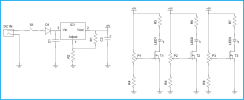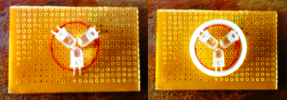Here is an economical way to experiment with light, color, and optics. You get one Red LED light source, one Green LED light source, and one Blue LED light source. The three LEDs can be controlled independently of each other, and this can be used as a light source in microscopes. From Optical physics (and as shown by Maxwell), it is with our knowledge that there are three types of primary colors, namely, Red,Green and Blue (RGB). Any other color of whatever shade may be produced by mixing appropriate propotions of these three primary colors!
Schematic of the Microscope LED Light Circuit

Parts list

As shown in the photograph, the three LEDs can be fitted in a small piece of (~ 60mm x40mm) veroboard. This allows easy placement of the unit on the top of the glass specimen carrier (incase of a space restriction , try to use a trimmed down version of the board). The ring is nothing but a plastic one with near 25mm outer diameter and 10mm height, directly glued on the top of the PCB. If available, use a black ring rather than a white one. Similarly, try to use diffused LEDs, or carefully convert the existing LEDs to diffused LEDs with the help of some sandpaper/similar abrasive material. Rest of the circuit should be enclosed in a small box, and use suitable wires/cable for interconnection between the LED board and the Driver box.
The circuit can be powered from any good-quality 9 to 12VDC power supply, thanks to the onboard 5V regulator wired around LM317 (IC1).The potentiometers P1, P2 and P3 (in connection with mosfets T1,T2 and T3) allow the intensity of each color to be individually adjusted, while S1 acts as the master on/off switch.
Notes
Schematic of the Microscope LED Light Circuit

Parts list
- S1: SPST On/Off Switch
- D1: 1N 4007
- C1: 100nF
- IC1: LM317T
- C2: 10uF/16V
- R1: 220 R
- R2: 680R
- R3: 270R, R5: 120R , R7: 120R / R4,R6,R8: 10K
- P1,P2,P3: 10K Multi-turn POTs
- LED1, LED 2, LED3 : 5mm Red x1, 5mm Green x1 , 5mm Blue x1
- T1,T2,T3: STP60NF06 MOSFETs

As shown in the photograph, the three LEDs can be fitted in a small piece of (~ 60mm x40mm) veroboard. This allows easy placement of the unit on the top of the glass specimen carrier (incase of a space restriction , try to use a trimmed down version of the board). The ring is nothing but a plastic one with near 25mm outer diameter and 10mm height, directly glued on the top of the PCB. If available, use a black ring rather than a white one. Similarly, try to use diffused LEDs, or carefully convert the existing LEDs to diffused LEDs with the help of some sandpaper/similar abrasive material. Rest of the circuit should be enclosed in a small box, and use suitable wires/cable for interconnection between the LED board and the Driver box.
The circuit can be powered from any good-quality 9 to 12VDC power supply, thanks to the onboard 5V regulator wired around LM317 (IC1).The potentiometers P1, P2 and P3 (in connection with mosfets T1,T2 and T3) allow the intensity of each color to be individually adjusted, while S1 acts as the master on/off switch.
Notes
- High-Intensity,Diffused LEDs are good for this circuit
- Literally, Giant Power Mosfets are used here. This is an intentional implementation to increase the circuit flexibility
- Due to component tolerance, it may become necessary to alter the values of resistors R3 to R8
- This is an Unorthodox & Generic Design. Be prepared to carry out some experimenting to get the results you want!
Eklentiler
Son düzenleme:


